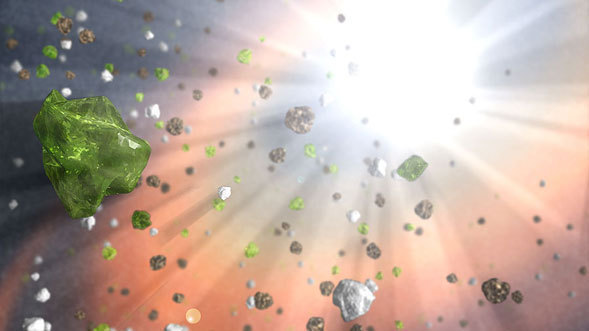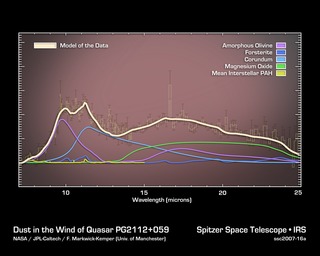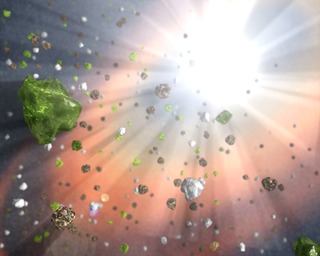
Credit: NASA/JPL-Caltech/F. Markwick-Kemper (University of Manchester)
Chart • October 9th, 2007 • ssc2007-16a
ssc2007-16a
The hit song that proclaimed, "All we are is dust in the wind," may have some cosmic truth to it. New findings from NASA's Spitzer Space Telescope suggest that space dust -- the same stuff that makes up living creatures and planets -- was manufactured in large quantities in the winds of black holes that populated our early universe.
The findings are a significant new clue in an unsolved mystery: where did all the dust in the young universe originate?
"We were surprised to find what appears to be freshly made dust entrained in the winds that blow away from supermassive black holes," said Ciska Markwick-Kemper of the University of Manchester, U.K. Markwick-Kemper is lead author of a new paper appearing in an upcoming issue of the Astrophysical Journal Letters. "This could explain where the dust came from that was needed to make the first generations of stars in the early universe."
Space dust is essential to the formation of planets, stars, galaxies and even life as we know it. The dust in our corner of the universe was piped out by dying stars that were once a lot like our sun. But, when the universe was less than a tenth of its present age of 13.7 billion years, sun-like stars hadn't been around long enough to die and make dust. So, what produced the precious substance back when the universe was just a toddler?
Theorists have long-postulated that short-lived, massive exploding stars, or supernovae, might be the source of this mysterious dust, while others have proposed that a type of energetic, growing supermassive black hole, called a quasar, could be a contributing factor. A quasar consists of a supermassive black hole surrounded by a dusty doughnut-shaped cloud that feeds it. Theoretically, dust could form in the outer portion of the winds that slowly blow away from this doughnut cloud.
About the Object
- Name
- PG2112+059
- Type
- Galaxy > Activity > AGN > Quasar
- Galaxy > Activity > AGN > Quasar
- Distance
- 8,200,000,000 Light Years
- Redshift
- 0.466
Color Mapping
| Band | Wavelength | Telescope |
| Infrared | Spitzer IRS |






